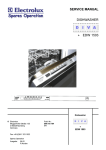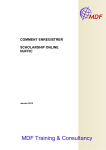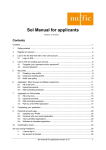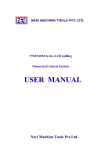Download Atlas user manual for Netherlands Embassies
Transcript
Atlas User Manual for Netherlands Embassies Table of Contents Table of Contents.................................................................................................... 2 Introduction............................................................................................................ 3 1 How to access atlas .......................................................................................... 5 2 Assessment of NFP and MSP candidates .......................................................... 7 2.1 Eligibility check ....................................................................................................... 12 2.2 Assessment ............................................................................................................ 14 2.3 No eligibility check ................................................................................................. 16 2.4 No assessment of eligible applications ................................................................... 16 2.5 Overview of your assessment and keeping a record ............................................... 16 3 The selection of NFP and MSP fellowship holders .......................................... 18 4 Follow‐up and alumni .................................................................................... 20 Annexes ................................................................................................................ 21 Annex 1 ................................................................................................................ 22 2 Introduction The procedure of NFP II and MSP II As of the November 2014 deadline the procedure of the Netherlands Fellowship Programmes (NFP II) and the Mena Scholarship Programme (MSP II) have changed. The Dutch higher education institutions that participate in NFP and MSP submit their grant application through Atlas – a newly developed software to administrate NFP and MSP grants from the beginning to the end of each fellowship. Each Dutch institution does a grant application per sub-programme per deadline for short courses, master’s degree programmes or PhD researches, which they offer. The number of nominated candidates in one grant application is based on the number of fellowships that an institution received in the past. However, the number of nominations is around three times bigger than the number of fellowships that can be paid from the deadline budget. This way the Netherlands embassies have the opportunity to identify the most suited candidates for an NFP or MSP fellowship and the pool of candidates will be sufficiently large to meet the requirements the Dutch Ministry of Foreign Affairs has set for the programmes (e.g. 50% of the fellowships must be allocated to women). On the other hand the number of applications that embassies have to check is always limited because the Dutch institutions cannot nominate more candidates than the number determined by EP-Nuffic for that sub-programme-deadline. Atlas facilitates the embassies in the identification process of suitable candidates. After the deadline for the Dutch Institutions for submitting their grant application has closed the nominated candidates of all institutions are for embassies available in Atlas. They are sorted by country so you only see NFP and MSP candidates whose employer is situated in your country. This manual gives a detailed instruction on how to access Atlas (chapter 1) and assess the NFP and MSP candidates of your country or countries in Atlas (chapter 2). Furthermore it sketches the process from there onwards to give you an idea how the selection is done (chapter 3) and what you can expect after fellowship holders have been appointed (chapter 4). The objectives of NFP and MSP II The Netherlands Fellowship Programmes promote capacity building by providing training and education fellowships for professionals within organizations in 51 countries that are important to the Dutch development cooperation policy. Fellowship holders will improve their knowledge and skills, learn about relevant global developments in their field and build an international network. This way the employing organisation directly invests in staff development and the fellowship holders invest in their further career. For the Netherlands, this programme amongst others serves to strengthen ties with the fellowship holder’s country and promote trade relationships. After completing the education fellowship holders return to their original workplace. This ensures the training is embedded within the organisation. The Middle East and North Africa (MENA) Scholarship Programme (or MSP) offers scholarships to professionals from ten countries. The overall aim of the MSP is to contribute to the democratic transition in the participating countries and to help form a positive image 3 about the Netherlands. MSP aims to build capacity within organizations by enabling employees to take part in diploma or other courses. The NFP and MSP is initiated and fully funded by the Dutch Ministry of Foreign Affairs of the budget for development cooperation. 4 1 How to access atlas Each account is a unique combination of an account name and an email address. Your embassy has appointed one Central Contact Person for Atlas Accounts (CCA). This person manages your embassy’s accounts. Furthermore, we have decided to include a second CCA (CCA-V) in Atlas. If additional colleagues need access to Atlas, the CCA can request additional accounts. Only one account is created per person. To prevent unauthorized access, requests for a new Atlas account, changes to existing accounts or requests to close accounts can only be submitted by the CCA, using a form which you can find on the EP-Nuffic-homepage for Dutch Embassies www.EP-Nuffic.nl/nfp/embassies, which must be sent to [email protected]. General information and news on NFP and MSP will also be published on this website. To enter Atlas, use the link to get to the login screen. At your first login you will be asked to change your password. For an instruction on how to use the self-service please see Annex 1: Atlas, your account and password. After logging in you will see the welcome-page of Atlas. 5 Click on the tab “Eligibility check” to get to the screen in which you can do all your work for NFP and MSP. 6 2 Assessment of NFP and MSP candidates At this moment Atlas facilitates the administration and assessment of three sub-programmes of the Netherlands Fellowship Programmes (NFP) and the Mena Scholarship Programme (MSP). These programmes have different deadlines, see table 1. Programme NFP and MSP deadlines: closing months Master's degree programmes April, August Short courses April, August, November PhD November MSP April, August, November Table 1 The submit deadlines are on the first Tuesday of the month. The application period starts two months earlier. The deadline (e.g. August deadline) refers to the month in which the Dutch institutions have to submit their grant application. The embassies’ work can start at the same day, see timeframe marked blue in the scheme left. Before that time there will be no candidates visible in your assessment screen. You have four weeks to 1. check the eligibility of the nominated candidates, 2. indicate if the eligible applications can be assigned to one or more of the policy themes defined by the Ministry of Foreign Affairs 3. assess applications based on the assessment questions in Atlas. Please note that both eligibility reasons and assessment question are specific for each subprogramme. 7 After the start of the period for the assessment of NFP and MSP candidates you can go to your assessment screen and (1) select from the filter the country for which you want to do the candidate assessment – if you are the fellowship officer of more than one country - and (2) a sub-programme and deadline combination. When you press the “Search”- button (3) you will get a list of candidates nominated by all institutions from that country, sub-programme and deadline. 1. 2. 3. If you want a more specific list you can also filter on the status of the application and the policy theme. Please be aware that if you filter before you started your work this will not be useful as in this case all candidates have the status “nominated” and policy themes have not been assigned yet. If you then filter on any of the policy themes there will be no results. 8 If you want to search for a specific candidate you can use the fields for surname, date of birth or the embassy reference number (which can be added later) from the filter. Once you have the intended selection you can view the details of an applicant and his application by clicking on this icon: . A new window will open. 9 10 The Dutch institution is responsible for the correctness of the data with which they submitted their grant application to EP-Nuffic. Therefore the details are non-editable for you. If you notice any mistakes or untruthfulness in an application please contact the Dutch institution. In the majority of cases candidates themselves entered the data and it may have slipped the institution’s attention that this input contained mistakes. To make communication about a candidate between you and the Dutch institution easier you can see their reference number in the section “Study programme”. The only section you can edit is the one with the heading “Embassy”. The entire assessment of an application is done here. You can give a reference number to a candidate for your own record or for example in order to notify the visa-department in an early phase. The assessment of an application consists of three steps: 1. the eligibility check; 2. the assessment of an application; 3. decide whether an application is attributable to one or more policy themes and mark this decision in Atlas. 11 2.1 Eligibility check The first step in the assessment of an application is the eligibility check. The eligibility criteria for NFP and MSP are published on EP-Nuffic’s website for embassies. Atlas provides all information on which you can base your decision whether a candidate and his application are eligible for NFP or MSP or not. In case an application is not eligible you should mark the “Not eligible” bullet after which a list with rejection reasons will unfold. It is mandatory to choose at least one rejection reason to be able to save the eligibility decision. However, it is important to make the rejection as exhaustive as possible. Two reasons why this is important: 1. firstly, because if one rejection reason happens to be given unjustly and a candidate files an objection it is not possible to bring up other eligibility criteria, which he did not meet but which were not listed in the rejection letter. 2. secondly, because for the next deadline an institution might again nominate the same candidate without the previous mistake. For example, if the rejection reason mentioned before was something that can be improved, like the employer’s letter. If this same candidate was also not eligible because for example you consider his employer an 12 organization which is excluded from participating in NFP and you did not mention this rejection reason the first time, then the institution might nominate him again. If this time you reject the candidate on the ground that his employer is not eligible for NFP this will have as a consequence that the institution will lose one of their nominations and they will not understand why the same employer is eligible in the first application and not eligible in the second. Each rejection reason is a specification on why the application does not meet an eligibility criterion. This specification is necessary because the Dutch institutions will have to send the rejection letters or mails in which they inform candidates of their non-eligibility. As they are not the ones who rejected the applicants it is important that you are specific with your motivation to exclude an applicant from NFP. The denotative reasons, which are visible to you in the above screen, are coupled to more precise descriptions, which will be used by the Dutch institutions for making the rejection letters. For example, one of the eligibility criteria is: To be eligible a nominated candidate must have an official and valid passport. There are five ways in which an applicant cannot meet this eligibility criterion: Sub-programme for which this rejection reason is applicable Document Denotative description of the embassy checkbox Precise description for the rejection letter; coupled to the denotative description NFP-SC, NFP-MA, NFP-PhD, MSP-SC ID Identification document is expired The identification document which you attached is expired. NFP-SC, NFP-MA, NFP-PhD, MSP-SC ID Identification document is forged The validity of your identification document could not be confirmed. NFP-SC, NFP-MA, NFP-PhD, MSP-SC ID Identification document is not official The identification document you attached is not an official document of identification in your country. NFP-SC, NFP-MA, NFP-PhD, MSP-SC ID Identification document is not provided You did not provide an identification document. NFP-SC, NFP-MA, NFP-PhD, MSP-SC ID Identification document is not readable The identification document you attached could not be opened or proved to be unreadable. For the complete table of rejection reasons and the text to which they are coupled see www.EP-Nuffic.nl/nfp/embassies. The Dutch institution will send the rejection letters after the selection, around three weeks after your deadline for the assessment of candidates closes. 13 In case an application is eligible you should mark the “Eligible” bullet. After saving the eligibility decision the assessment questions will unfold as can be seen in below screen shot. Only eligible applications will be further processed. 2.2 Assessment It is very important that you assess the applications. By assessing carefully you can make sure that: 14 ‐ ‐ the bilateral goals of the embassy and the objectives of NFP/MSP can be met. NFP and MSP are tools for the Netherlands embassies with which they can support their own bilateral goals, for NFP this is with regard to development cooperation. a ranking of all eligible candidates is possible. After the assessment deadline closes the candidates of all countries will be ranked based on the assessment you and your fellowship officer colleagues at other embassies made. Without your assessment there is no ranking of candidates and the selection of fellowship holders will be random. The objective of NFP and MSP cannot be met when fellowships are distributed randomly! The assessment of each application depends on your conclusion on how relevant the knowledge is for the country. How to assess an application In order to get a good picture of the applicant and the application as a whole and give wellconsidered answers to the assessment questions in Atlas it is important to examine: - to what extend the application fits into the objective and target group of NFP or MSP respectively; - If the application fits one or more of the policy themes of the programmes (as far as NFP is concerned); - If the application fits the country focus (NFP or MSP) in order to contribute to the development of the country; - How the chosen course, programme or research fits with the tasks of the candidate; - To what extend the position of the applicant allows for a good implementation and dissemination of the newly-acquired knowledge in his daily work; - How well the plans for the time after returning to the employer are described and how easily they can be implemented; - The quality of the answers to the motivation questions; - The quality of the employer’s statement. For each question you can give a rating, see screen shot above. The default is always poor/not assessed which equals zero points later on in the calculation of the score of the application. Excellent equals the maximum number of points. Apart from answering the assessment questions it is also very important that you decide whether an application is attributable to one or more policy themes that have been determined by the Dutch Ministry of Foreign Affairs and mark this decision in Atlas. When Atlas executes the selection it will allocate 35% of the budget to applications that improve Food Security in NFP countries. The selection method identifies applications that belong in this category as such by looking at the policy theme that fellowship officers attributed to them. Marking an application as food-security-relevant thus has great influence on the chance of it being selected. Nonetheless, applications with a good rating that are food-security-relevant have a much higher chance of being selected than applications with a poor or mediocre rating that are food-security-relevant. Please see the explanation of the selection method in chapter 3. You can mark an application as food-security-relevant by checking the applicable bullet under the heading ‘policy theme’: 15 In Atlas you do not need to submit your assessment. When you save your work the status of the application changes automatically and the information is immediately accessible to EPNuffic employees. You can change your eligibility decision and your assessment until the deadline of the assessment period of four weeks has closed. Applications that you have not worked on yet have the status ‘nominated’. Applications that you have judged on their eligibility have the status ‘eligible’ or ‘not eligible’. Applications that are eligible and have been assessed have the status ‘assessed’. 2.3 No eligibility check If you forget to do the eligibility check or the embassy decides not to invest time in the eligibility check of NFP or MSP candidates, the application will be given the status ‘not eligible’ when the deadline for the assessment passes. These applications will not participate in the selection. The applicant will receive a rejection letter with the following reason: “No eligibility check” 2.4 No assessment of eligible applications If you do not assess an application (if you do not answer the assessment questions) the application will participate in the selection with the lowest rating. The chance of this application being selected is very low although it is possible that it will be selected depending on whether it fits into one or more of the priority areas. 2.5 Overview of your assessment and keeping a record Atlas offers two tools to keep an overview of your work and the applications for your country. 1. You can view and save all applications or the applications that fit a certain selection by using the -button. The excel document that opens will only show the result of your filter if you applied one before doing the export. In contrast to the screen in Atlas the excel documents show all filled-in fields of an application. 16 This functionality is useful to build up a record of past applications (possibly the applications that were not selected. These have to be deleted from Atlas periodically because of the Dutch privacy law). It is also useful to create a reference work for example to keep a record of which employing organizations you marked not eligible in the past because they were too big. This way you prevent discussions with applicants whose colleagues were not rejected for working for the same organization as they. 2. You can download an overview of your assessment of a selected sub-programmedeadline by pushing the blue ‘overview assessments’-button. The excel-document that opens shows you three sheets. The first sheet contains a lists of not eligible candidates and their rejection reasons, the second sheet contains a list of assessed candidates with their assessment per question, and the third sheet contains an overview of all candidates from the chosen sub-programme-deadline including the applications you have not yet checked. This list is useful if you would like one of your colleagues to check your work or if you want to compare the assessment you gave different candidates. 17 3 The selection of NFP and MSP fellowship holders After the deadline for assessing EP-Nuffic makes a selection from the eligible candidates that have been assessed by the embassies. EP-Nuffic makes the selection with the help of the Atlas selection tool. It puts the eligible candidates of all countries on one list and sorts them by their score. From this sorted list the selection tool picks fellowship holders with the highest score one by one in a way that all four priorities of NFP will be met. In order of importance the priorities are: 1. At least half of the budget per sub-programme per deadline must be allocated to applications from Sub-Sahara Africa. 2. At least 35% of the budget must be allocated to application that fit the policy theme Food Security. 3. At least 67% of the budget must be allocated to fellowships from countries of the category 1. 4. At least half of the fellowships must be allocated to women. Thus, applications with a higher rating are always preferred within the same policy theme above those with a lower rating. To give a simplified example with only 15 eligible candidates: Assuming that from these 15 candidates six will be selected for a fellowship (and assuming that all fellowships cost the same) #1, #2, #6 and #7 would be selected to fulfill the requirement that at least 50% of the budget are spent on candidates from Sub-Sahara Africa. Rating Candidate from ID Embassy Sub-Sahara Food Africa Security Country Category M/F #1 34 yes yes 1 M #2 30 yes yes 1 F #3 27 no yes 1 F #4 22 no no 2 M 18 #5 19 no no 2 M #6 18 yes yes 1 F #7 16 yes no 1 F #8 14 no no 1 M #9 11 yes no 2 M #10 10 yes yes 1 F #11 7 no no 1 M #12 4 no yes 1 M #13 2 no no 1 M #14 0 yes yes 1 F #15 0 no yes 2 M #3 would be selected to make sure 35% of the budget is spent on candidates that fit the policy theme Food Security. With this selection 67% of the budget would already be spent on category 1 countries and 50% of the fellowships go to women. After that there is budget for one more fellowship, which will be awarded to candidate #4, because he has the highest score and the priorities are already met by the selection of the previous five fellowship holders. For comparison, #10 and #14 whose applications fit all four priorities but were of lower quality have not been selected. In reality the selection tool has to pay attention to the maximum and minimum number of fellowships an institution’s course can accommodate and the very diverse costs for different fellowships. After the selection has been confirmed by the authorized person at EP-Nuffic, the institutions will be informed of their grant and the candidates that were selected. 19 4 Follow-up and alumni Will follow soon. 20 Annexes 21 Annex 1 Atlas: your account and password Procedures for institutions and embassies 1. First time use of account 2. Log in in to Atlas 3. Password selfservice 1. First time use of account The account holder receives an e‐mail with Username, temporary Password and url of the selfservice and logs in: https://selfservice.nuffic.nl/atlas/default.aspx Fill in the Username and the temporary Password which you received by email and click on [Sign in]. On first use of your account you are required to change the temporary password to one of your own choosing. 22 Fill in the temporary Password in the field [Old password], your new Password in the field [New password] and Confirm. Make sure you meet the Password Policy Restrictions (see below). Click on [Change]. Password Policy Restrictions The password policy requires that the password: - must be at least 8 characters - cannot contain the user's account or full name - must contain at least three of the following four character groups: - English uppercase characters (A through Z) - English lowercase characters (a through z) - Numerals (0 through 9) - Non-alphabetic characters (such as !, $, #, %) - must be changed at least every 182 days - cannot be changed until at least several minutes since it was last changed - cannot repeat any of the previous 20 passwords. You are encouraged to enroll in the Password Self‐Service. With this service you can change/reset your own password, when necessary. You may choose here for [Later]. In that case this pop‐up will be shown again on next use of the account. 23 When you choose to [Enroll Now], you are requested to define and answer two Security Questions. Click on [Save]. 24 2. Log in in Atlas To log in in Atlas go to: https://atlas.nuffic.nl/ Enter your Username and Password. Click on [Log on]. When the login fails, the user should go to the Password Selfservice (see below) for a password reset. 3. Password selfservice A. Change password The password can be changed any time by the user. Log in at https://selfservice.nuffic.nl/atlas/default.aspx with the present username and password and choose the option [Change password]. B. Password expiry The Atlas password expires after 6 months. Ten days before expiry an email is sent to inform the user. The password can be changed following procedure A (above). Even when the password has expired, the password can be changed through this procedure (A). C. Password forgotten When the user has forgotten his/her password, there are 2 options: 1. Earlier the user has chosen not to enroll in the ‘Self Password Reset – Enroll’ The user can not reset his/her password and must ask Nuffic to reset the password. 2. Earlier the user has chosen to enroll in the ‘Self Password Reset ‐ Enroll‘ Go to the selfservice: https://selfservice.nuffic.nl/atlas/default.aspx and enter your username (and not the password, because you have forgotten it) en click on the option [Forgot your password?] 25 Click on [Forgot your password?] Click on [Next]. An email with a Verification Code will be sent to you. 26 You receive an email with a Verification Code. Enter this Verification Code and click on [Next]: You are now asked to answer the two Security Questions: 27 After answering the Security Questions you will be asked to provide a new password: Click on [Next] You will receive a confirmation by email. 28





































